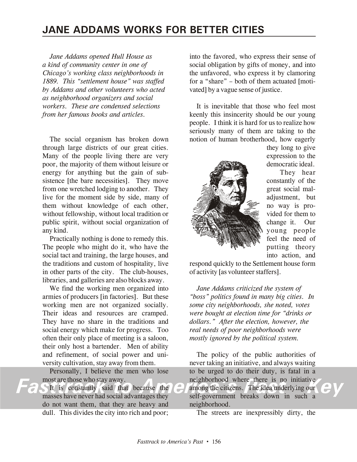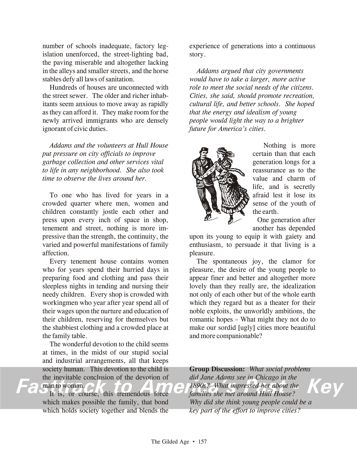| Fasttrack
to America's Past Teacher Key |
|
| Fasttrack
to America's Past Teacher Key |
|
 Page 156  Page 157 |
Pages 156
& 157 - Jane Addams Works for Better Cities The reading selection The selections on these pages are drawn from the books and articles of Jane Addams, the famous social reformer of her time. Addams opened Hull House as a kind of community center in one of Chicago's immigrant neighborhoods in 1889. Volunteers came to help, and Hull House became the first of many "settlement houses" that were soon spreading to other cities. As the selections here show, Addams had a remarkable ability to understand and describe the human story of life in a great American city of the late 19th and early 20th centuries. The pictures 1. Jane Addams, the social reformer who started Hull House in Chicago. Although she was from a wealthy family, she found her calling in the run-down tenement neighborhoods of that city. 2. A young couple ice skating. Jane Addams hoped that the idealism of young people would be a force for improving life in America's cities. Group discussion questions The rich, she says, are doing well for themselves. Addams mentions their large houses, and access to club-houses, libraries, and art galleries. It is not just money, however, that defines the difference between the rich and poor. Addams has in mind social wealth, not just cash totals. The poor live in a social world that is "broken down" and "without fellowship, without local tradition or public spirit, without social organization of any kind." Addams understands that progress for the poor requires not just "gifts of money," but action to build up social wealth - what sociologists today would call social capital. The purpose of Hull House was, in large part, to help residents in the area develop the "traditions and social energy which make for progress." The rich have such traditions already, she says, but live in other parts of the city, avoiding contact with the less fortunate. Their gifts of money to help the poor are not, by themselves, the answer to the "great social maladjustment." Addams sees the settlement house movement as a better answer, with it's emphasis on young, educated people volunteering for one-to-one work helping the poor learn how to help themselves. Jane Addams
gives an example
of the miserable conditions in one of the poor areas of Chicago.
It is dirty, neglected by political leaders and even, it seems, by
sanitary
inspectors. The political system simply did not function, she
says,
"because there is no initiative among the citizens." Indeed,
Addams
says, "The idea underlying our self-government breaks down in such a
neighborhood."
Indeed, Addams said such bonds and the devotion of families to their children seemed "at times... all that keeps society human." On such a solid foundation, she knew, great social progress could be built. Addams thought that young people could be a key part of the effort to improve cities because of their natural energy and idealism. Addams describes how young people see each other, and indeed the entire world, as ripe with beauty and possibility. The reality of cities like Chicago often fell short on such attributes, as her account shows. But if young people imagined what cities could be, there would be no limit to what they might accomplish. The young, Addams reminds us, idealize not only each other, but "the whole world, which they regard but as a theater for their noble exploits."
|
|
Copyright Notice
Copyright 2018 by David Burns. All rights reserved. Illustrations and reading selections appearing in this work are taken from sources in the public domain and from private collections used by permission. Sources include: the Dover Pictorial Archive, the Library of Congress, The National Archives, The Hart Publishing Co., Corel Corporation and its licensors, Nova Development Corporation and its licensors, and others. Maps were created or adapted by the author using reference maps from the United States Geological Survey and Cartesia Software. Please see the home page for this title for more information. |